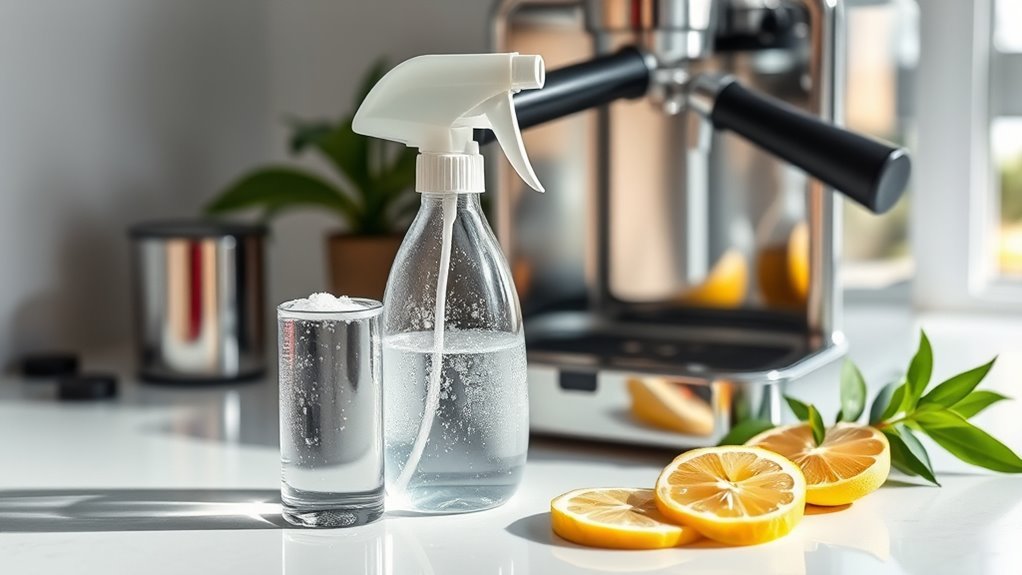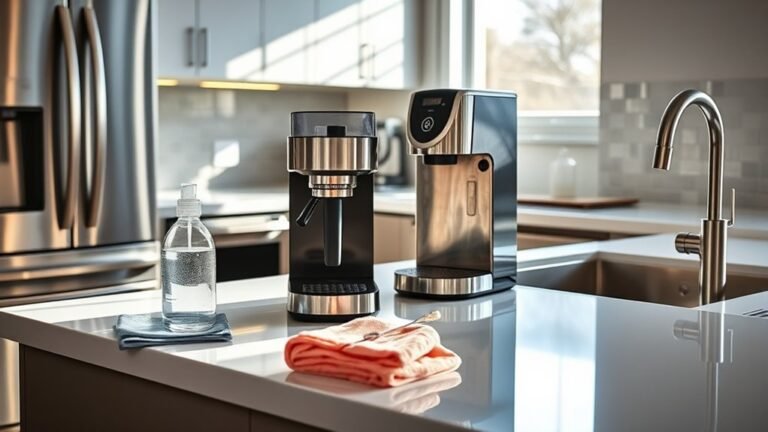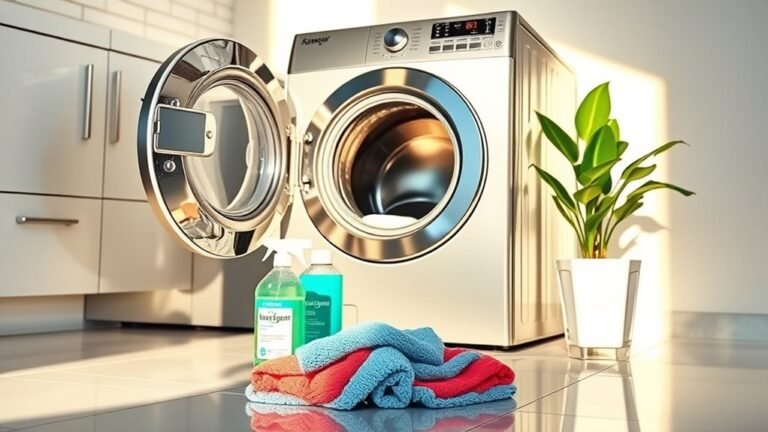DIY Cleaner for Coffee Machine Surfaces
You can make an effective DIY cleaner for your coffee machine surfaces using common kitchen staples like vinegar and baking soda. Mix half a cup of vinegar with two tablespoons of baking soda for a natural, non-toxic solution that breaks down buildup and eliminates odors. Use a soft cloth or sponge to apply it, then wipe clean. This simple method keeps your machine spotless and fresh—there’s plenty more to know about maintaining your coffee machine’s shine and function.
Why Use a Homemade Cleaner for Coffee Machines
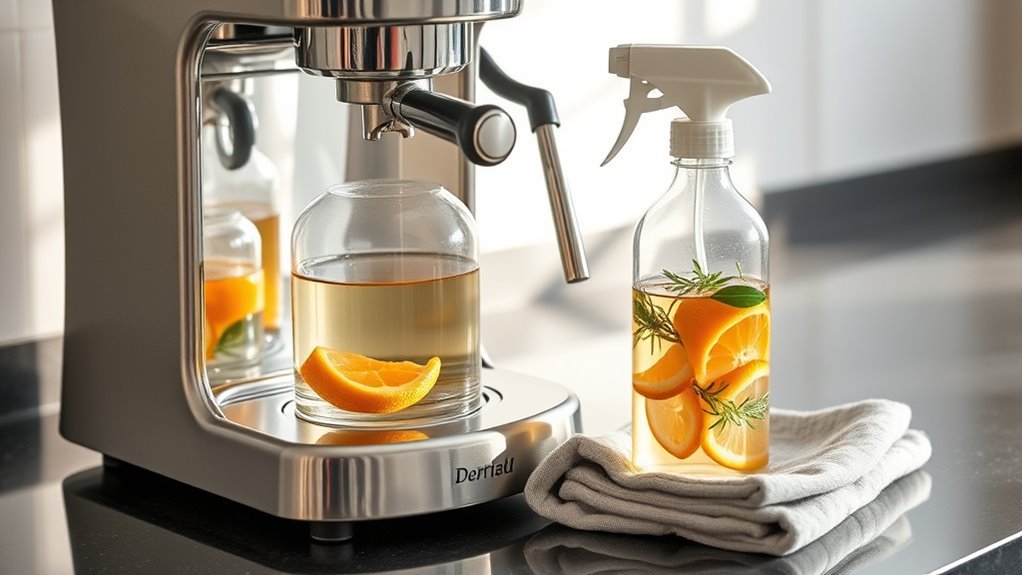
Although commercial cleaners can be convenient, you’ll find that homemade cleaners are often safer and more cost-effective for your coffee machine surfaces. When you make your own cleaner, you’re choosing a cost effective solution that not only saves money but also gives you control over what touches your beloved equipment. You avoid harsh chemicals that might damage your machine or harm your health. Plus, by opting for a homemade cleaner, you’re embracing an eco friendly option, reducing plastic waste and toxic runoff. This freedom to customize and protect your coffee maker aligns perfectly with a lifestyle that values sustainability and independence. You get to keep your machine spotless without compromising your values or your budget. Homemade cleaners truly empower you to care for your coffee ritual responsibly.
Essential Ingredients for DIY Coffee Machine Cleaner
When you’re ready to make your own coffee machine cleaner, knowing which ingredients to use is key. You’ll want to grab cleaning vinegar and baking soda—two powerhouse ingredients that tackle grime without harsh chemicals. Cleaning vinegar’s natural acidity breaks down mineral buildup and coffee stains effortlessly, while baking soda acts as a gentle abrasive and neutralizes odors. Together, they create a safe, effective cleaner that respects your machine and the environment. You don’t need complicated additives or expensive products—just these simple staples from your pantry. Using them not only gives you control over what touches your coffee machine surfaces but also frees you from relying on commercial cleaners filled with unknown ingredients. With cleaning vinegar and baking soda, you’ve got a straightforward, budget-friendly solution to keep your coffee setup spotless.
Tools Needed to Prepare and Apply the Cleaner
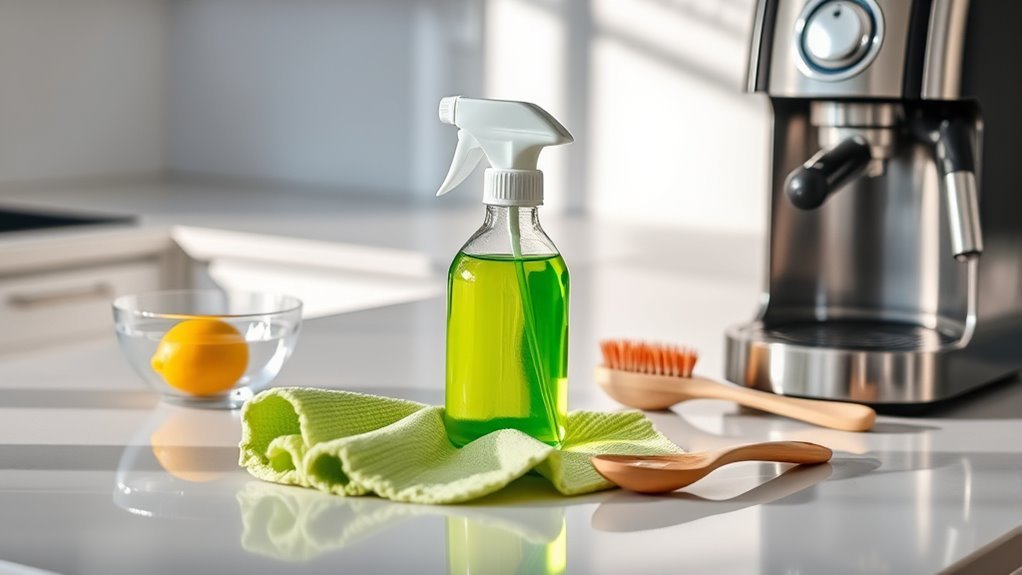
To get started, you’ll need a few essential tools to prepare and apply your DIY cleaner effectively. This includes common kitchen items for mixing, as well as materials like soft cloths or brushes for cleaning. Having the right equipment on hand will make the process smoother and guarantee your coffee machine gets a thorough clean.
Essential Cleaning Tools
You’ll need a few basic tools to prepare and apply your DIY cleaner effectively. Start with cleaning brushes—they’re perfect for reaching tight corners and stubborn grime on your coffee machine surfaces. Choose brushes with soft bristles to avoid scratches but firm enough to lift dirt. Next, microfiber cloths are essential. They’re great for wiping down surfaces without leaving lint or streaks, ensuring a spotless finish. These cloths also absorb the cleaner well, helping you control application and avoid waste. Having a small funnel and a clean container for mixing your cleaner keeps things tidy and precise. Gathering these essential cleaning tools gives you the freedom to maintain your coffee machine with ease, keeping every surface fresh and ready for your next brew.
Application Materials Needed
Once you have your cleaning tools ready, gathering the right materials for applying your DIY cleaner will make the process smoother and more effective. You’ll want soft microfiber cloths—they’re gentle on all surface types, preventing scratches while wiping away residue. A small spray bottle helps you control the cleaner’s application, so you avoid over-wetting sensitive areas. Depending on your machine’s finish, cotton swabs or soft-bristle brushes can reach tight spots without damage. Keep in mind your preferred cleaning frequency; having these materials handy encourages regular upkeep, preserving your machine’s look and function. Choosing the right application materials empowers you to clean confidently and efficiently, maintaining your coffee machine’s surfaces exactly how you like them—fresh, spotless, and ready for your next brew.
Preparation Equipment List
Gathering the right tools is essential for preparing and applying your DIY coffee machine cleaner effectively. To get started, you’ll need a few basic items: a measuring cup or spoon for accurate ingredient portions, a mixing bowl or jar for blending, and a spray bottle or soft cloth for application. Having gloves handy protects your hands during application, especially if you’re using acidic ingredients. A soft brush or toothbrush helps tackle tough spots without scratching surfaces. Mastering simple preparation techniques like thorough mixing guarantees your cleaner works at its best. Remember, sticking to a regular cleaning frequency keeps your machine in top shape and prevents buildup. With these tools, you’re free to maintain your coffee machine’s shine and functionality without relying on expensive products.
Step-by-Step Guide to Making the Cleaner
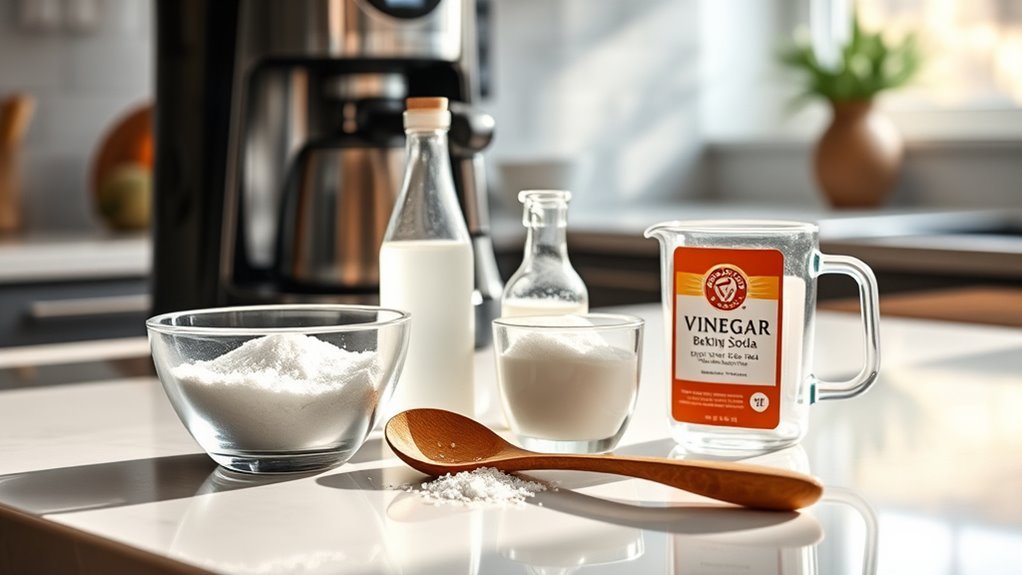
Now that you have your tools ready, it’s time to gather the essential ingredients for the cleaner. You’ll learn how to mix them properly to create an effective solution. Then, we’ll walk you through the application process step by step.
Essential Ingredients Needed
Before you start mixing your DIY cleaner, it’s important to know exactly which ingredients you’ll need to get the best results. You’ll want a vinegar solution because it’s a powerful natural disinfectant that cuts through grime without harsh chemicals. Pair it with baking soda, which acts as a gentle abrasive, perfect for scrubbing away stubborn stains without scratching your coffee machine surfaces. These two ingredients work in harmony, giving you a cleaner that’s both effective and safe. You’ll also need some water to dilute the vinegar solution to the right strength. Optional extras like a few drops of essential oil can add a fresh scent, but the core ingredients remain vinegar solution, baking soda, and water—simple, accessible, and freeing you from commercial cleaner dependence.
Mixing and Application Process
To make your DIY cleaner, start by combining half a cup of vinegar solution with two tablespoons of baking soda in a bowl. These mixing ratios are key to achieving an effective yet gentle cleaner for your coffee machine surfaces. Stir the mixture slowly to avoid excessive fizzing, ensuring the ingredients blend smoothly.
For application techniques, dip a soft cloth or sponge into the solution, then gently wipe down the machine’s exterior and removable parts. Avoid soaking electrical components. Let the cleaner sit for a few minutes to break down grime before rinsing with a damp cloth. This straightforward mixing and application process gives you full control over the cleanliness of your coffee machine without relying on harsh chemicals. Enjoy the freedom of a homemade, eco-friendly solution!
How to Safely Clean Different Coffee Machine Surfaces
Although coffee machines may look straightforward, each surface requires a specific cleaning approach to avoid damage and maintain functionality. You’ll find various surface materials like stainless steel, plastic, glass, and rubber, each demanding a different touch for cleaning safety. For stainless steel, use a soft cloth with your DIY cleaner to avoid scratches. Plastic parts should be wiped gently to prevent discoloration or warping. Glass surfaces need a streak-free approach—opt for a microfiber cloth. Rubber seals and gaskets require careful cleaning to maintain their flexibility and prevent deterioration. Always avoid harsh chemicals or abrasive tools that might harm your machine’s surfaces. By respecting the unique needs of each material, you keep your coffee machine looking great and working smoothly, giving you the freedom to enjoy every cup without worry.
Tips for Maintaining a Spotless Coffee Machine
Since a spotless coffee machine not only looks great but also brews better-tasting coffee, keeping it clean should be part of your regular routine. To enjoy this freedom, set a cleaning frequency that fits your usage—daily wiping of surfaces and weekly deep cleans work well for most. Regular maintenance prevents buildup, ensuring every cup is fresh and flavorful. Don’t forget to clean removable parts like filters and drip trays promptly. Use your DIY cleaner to tackle stubborn spots without harsh chemicals. By staying consistent, you avoid overwhelming chores and keep your machine running smoothly. Embrace these simple tips, and you’ll free yourself from worries about grime, letting your coffee machine shine and perform at its best every day.
Natural Alternatives to Enhance Cleaning Power
Keeping your coffee machine spotless doesn’t have to rely solely on commercial cleaners or harsh chemicals. You can opt for natural alternatives that are both effective and kind to the environment. Eco friendly options like white vinegar, baking soda, and lemon juice work wonders in cutting through grime and mineral buildup. Citrus extracts, in particular, offer a fresh scent and powerful grease-fighting abilities without any toxic residue. Just mix a few drops of citrus essential oil with water and vinegar to create a simple, non-toxic cleaner that leaves your machine shining. Embracing these natural ingredients gives you the freedom to clean confidently, knowing you’re protecting your health and the planet. With these alternatives, maintaining your coffee machine becomes easier and eco conscious.
Common Mistakes to Avoid When Cleaning Your Coffee Machine
When you clean your coffee machine, skipping important steps or using the wrong products can do more harm than good. One common mistake is ignoring the recommended cleaning frequency. Waiting too long allows buildup that’s tougher to remove and can damage your machine. Also, don’t use abrasive cleaners on delicate surface types like glass or stainless steel—they can scratch or dull the finish. Another pitfall is soaking electrical parts; water damage is a real risk. Instead, use a damp cloth with a gentle, DIY cleaner suited for your machine’s surfaces. Finally, avoid rushing—give cleaners time to work and rinse thoroughly to prevent residue. By steering clear of these errors, you’ll keep your coffee machine running smoothly and looking great, all while enjoying the freedom of DIY care.
Frequently Asked Questions
Can DIY Cleaners Damage the Internal Parts of My Coffee Machine?
Think of your coffee machine as a delicate garden; using harsh chemicals is like flooding it with stormy rain—it can erode the roots. When you pick cleaner ingredients, you’re choosing gentle rain and sunshine that nurture growth. If you’re careless, you might damage internal parts, so always opt for mild, natural solutions. This way, you maintain your machine’s health and enjoy the freedom of brewing perfect coffee without worry.
How Often Should I Descale My Coffee Machine?
You should stick to a descaling frequency that matches your machine’s usage and water hardness. Generally, descaling every 3 months keeps things running smoothly, but if you love coffee daily or have hard water, you might want to do it more often. Incorporate descaling into your maintenance schedule to avoid buildup and enjoy freedom from clogs or bad taste. Staying consistent means your coffee machine stays happy and brewing great every time.
Are DIY Cleaners Safe for All Coffee Machine Brands?
You might wonder if DIY cleaner ingredients work safely across all coffee machine brands. The truth is, compatibility varies. Some machines have sensitive components that harsh DIY solutions could damage. Always check your coffee machine compatibility before using homemade cleaners. Opt for gentle ingredients like vinegar and baking soda, but if your machine’s manual advises against certain substances, it’s better to follow those guidelines to keep your coffee setup running smoothly.
Can I Use Vinegar in My Coffee Machine Cleaner?
Oh sure, just pour vinegar in your coffee machine and hope for the best—it’s basically the magic potion of kitchen rebels! But seriously, vinegar benefits your coffee machine maintenance by cutting through mineral buildup and grime. It’s a natural, budget-friendly way to keep things running smoothly. Just don’t go vinegar-crazy; rinse thoroughly afterward to avoid sour coffee. Freedom’s great, but a little caution keeps your brew tasting free and fresh!
How Do I Store Leftover Homemade Cleaner Safely?
You’ll want to store leftover homemade cleaner in proper containers—glass or BPA-free plastic with tight lids work best to keep it fresh. Label the container with the date you made it to track storage duration easily. Generally, homemade cleaners last about a week or two, so don’t hang on to them forever. Keeping it cool and away from direct sunlight will also help maintain its effectiveness and your freedom to use it whenever you want.
